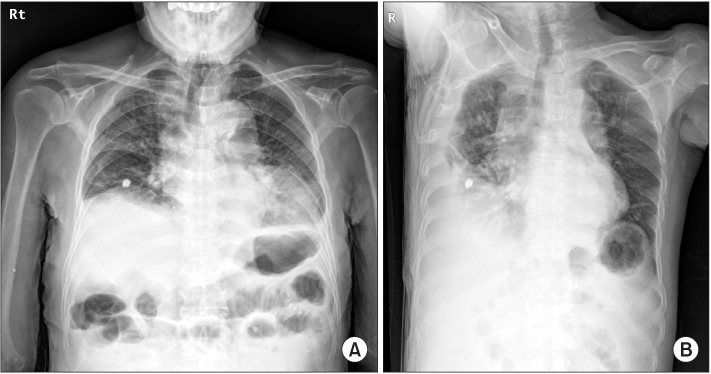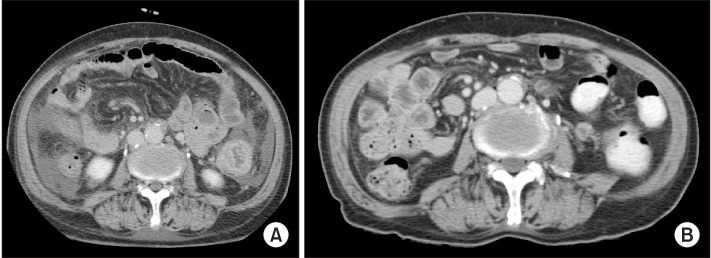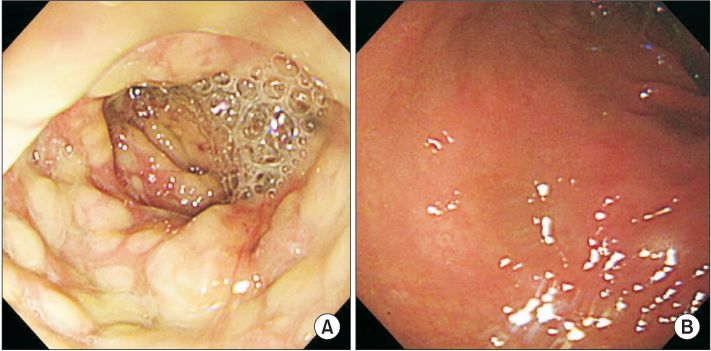Ewha Med J.
2015 Mar;38(1):54-58. 10.12771/emj.2015.38.1.54.
Pseudomembranous Colitis: A Complicated Case with Transient Increase of Carcinoembryonic Antigen
- Affiliations
-
- 1Division of Gasteroenterology, Department of Internal Medicine, Gwangju Veterans Hospital, Gwangju, Korea. nhlee365@bohun.or.kr
- KMID: 2171331
- DOI: http://doi.org/10.12771/emj.2015.38.1.54
Abstract
- Pseudomembranous colitis (PMC) is a frequent cause of morbidity and mortality among hospitalized patients. Although diarrhea is the most common manifestation, PMC may be associated with intraperitoneal fluid accumulation in the severe cases. And a few cases showing both ascites and pleural effusion have been reported in patients with PMC. We report a case of PMC who showed elevated serum and ascites levels of carcinoembryonic antigen (CEA) with a normal CEA level in pleural effusion and who successfully recovered after oral administration of metronidazole. After treatment, the serum CEA level returned to the reference range.
MeSH Terms
Figure
Reference
-
1. Zuckerman E, Kanel G, Ha C, Kahn J, Gottesman BS, Korula J. Low albumin gradient ascites complicating severe pseudomembranous colitis. Gastroenterology. 1997; 112:991–994.2. Kang CI, Lee HJ, Kim YT, Lee YH, Lee SY, Cho CM, et al. A case of pseudomembraneous colitis associated with ascites. Korean J Gastrointest Endosc. 2002; 25:466–469.3. Boaz A, Dan M, Charuzi I, Landau O, Aloni Y, Kyzer S. Pseudomembranous colitis: report of a severe case with unusual clinical signs in a young nurse. Dis Colon Rectum. 2000; 43:264–266.4. Kang SJ, Kim KH, Kim KS, Hur JH, Shin YM, Moon HG, et al. A case of pseudomembranous colitis with pleural effusion and ascites. Korean J Med. 2008; 74:Suppl 1. S53–S57.5. Monaghan T, Boswell T, Mahida YR. Recent advances in Clostridium difficile-associated disease. Gut. 2008; 57:850–860.6. Fordtran JS. Colitis due to Clostridium difficile toxins: underdiagnosed, highly virulent, and nosocomial. Proc (Bayl Univ Med Cent). 2006; 19:3–12.7. Kawamoto S, Horton KM, Fishman EK. Pseudomembranous colitis: spectrum of imaging findings with clinical and pathologic correlation. Radiographics. 1999; 19:887–897.8. Valiquette L, Pepin J, Do XV, Nault V, Beaulieu AA, Bedard J, et al. Prediction of complicated Clostridium difficile infection by pleural effusion and increased wall thickness on computed tomography. Clin Infect Dis. 2009; 49:554–560.9. Malati T. Tumour markers: an overview. Indian J Clin Biochem. 2007; 22:17–31.10. Duffy MJ. Carcinoembryonic antigen as a marker for colorectal cancer: is it clinically useful? Clin Chem. 2001; 47:624–630.11. Loewenstein MS, Rittgers RA, Feinerman AE, Kupchik HZ, Marcel BR, Koff RS, et al. Carcinoembryonic antigen assay of ascites and detection of malignancy. Ann Intern Med. 1978; 88:635–638.
- Full Text Links
- Actions
-
Cited
- CITED
-
- Close
- Share
- Similar articles
-
- A Case of Ascites by Pseudomembranous Colitis, Initially Diagnosed Malignant Asites
- A case of amebic colitis mimicking pseudomembranous colitis
- A Case of Pseudomembranous Colitis in Old Age which was Misdiagnosed as Acute Appendicitis with Perforation
- A Case of Rifampicin Induced Pseudomembranous Colitis in Elderly Patient
- A Case of Pseudomembranous Colitis Presenting as Toxic Megacolon and Protein Losing Enteropathy




